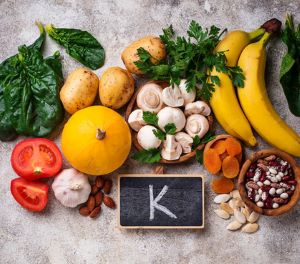Thinking about Potassium
By Reed Mangels, PhD, RD
The Dietary Guidelines for Americans categorizes potassium as “a dietary component of public health concern for the general US population because low intakes are associated with health concerns (1).” On average, people in the United States consume less potassium than is recommended (2). While the Dietary Guidelines call for eating more fruits and vegetables to get potassium, they also suggest that dairy products and fortified soy beverages can help to meet potassium needs. A cup of cow’s milk provides about 370 milligrams of potassium and a cup of soymilk supplies between 200 and 500 milligrams of potassium. Milk is not required, in my opinion, to meet potassium needs. There are many fruit and vegetable sources of potassium, some of which have more potassium in a serving than is found in a cup of cow’s milk or soymilk.
Potassium is an essential mineral. It is involved in kidney and heart function, muscle contraction, and the nervous system, among others. Higher intakes of potassium are associated with lower blood pressure and a reduced risk of hypertension and stroke (3). Potassium may also play a role in reducing the risk of kidney stones, type 2 diabetes, and low bone density (4).
The expert committee that develops dietary recommendations for Americans concluded that there was not enough data to develop Recommended Dietary Allowances (RDAs) for potassium. Instead, they established Adequate Intakes (AIs) based on the highest median intakes of potassium in healthy children and adults. The Adequate Intake (AI) for potassium is:
Birth to 6 months: 400 milligrams/day
7-12 months: 860 milligrams/day
1-3 years: 2000 milligrams/day
4-13 years: 2300 milligrams per day
14-18 years: 3000 milligrams/day (male); 2300 milligrams/day (female)
19 years and older: 3400 milligrams/day (male); 2600 milligrams/day (female)
Pregnancy: 2600 milligrams/day (14-18 years); 2900 milligrams/day (19 years and older);
Lactation: 2500 milligrams/day (14-18 years); 2800 milligrams/day (19 years and older)
Many whole plant foods supply us with potassium.
20 Good Sources of Potassium for Vegans
- Beet greens, 1300 milligrams of potassium in 1 cup cooked
- Plantains, 930 milligrams of potassium in 1 cup cooked
- Lima beans, 908 milligrams of potassium in 1 cup cooked
- Acorn squash, 896 milligrams of potassium in 1 cup cooked
- Soybeans, 882 milligrams of potassium in 1 cup cooked
- Spinach, 840 milligrams of potassium in 1 cup cooked
- Swiss chard, 792 milligrams of potassium in 1 cup cooked
- Pinto beans, 746 milligrams of potassium in 1 cup cooked
- Kidney beans, 722 milligrams of potassium in 1 cup cooked
- Split peas, 710 milligrams of potassium in 1 cup cooked
- Navy beans, 708 milligrams of potassium in 1 cup cooked
- Black-eyed peas, 686 milligrams of potassium in 1 cup cooked
- Lentils, 660 milligrams of potassium in 1 cup cooked
- Sweet potato, 572 milligrams of potassium in 1 cup cooked
- Chickpeas, 520 milligrams of potassium in 1 cup cooked
- Beets, 518 milligrams of potassium in 1 cup cooked
- Potato, 506 milligrams of potassium in 1 cup cooked
- Avocado, 488 milligrams of potassium in half
- Banana, 422 milligrams of potassium in 1 medium
- Dried apricots, 378 milligrams of potassium in ¼ cup
Food labels are required to include information about the potassium content of foods so if you’re curious about a specific food, check its Nutrition Facts Label.
To read more about potassium see:
Potassium Fact Sheet for Consumers (from National Institutes of Health; contains vegan and nonvegan sources of potassium)
The New Sodium and Potassium Recommendations and What They Mean for You
References
- U.S. Department of Agriculture and U.S. Department of Health and Human Services. Dietary Guidelines for Americans, 2020-2025. 9th Edition. DietaryGuidelines.gov. 2020.
- U.S. Department of Agriculture, Agricultural Research Service. What We Eat in America, 2017-March 2020. https://www.ars.usda.gov/ARSUserFiles/80400530/pdf/1720/Table_1_NIN_GEN_1720.pdf. 2022.
- O’Donnell M, Yusuf S, Vogt L, et al. Potassium intake: the Cinderella electrolyte. Eur Heart J. 2023;ehad628. doi:10.1093/eurheartj/ehad628
- National Institutes of Health, Office of Dietary Supplements. Potassium fact sheet for health professionals. https://ods.od.nih.gov/factsheets/Potassium-HealthProfessional/. 2022.

